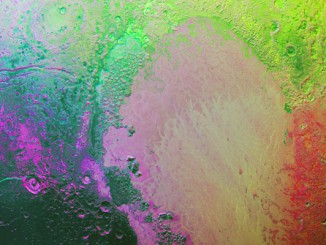
New Horizons science team members highlighted the latest findings from the Pluto flyby at the American Geophysical Union (AGU) fall meeting 14—18 December in San Francisco. Among the highlights were insights into Pluto’s geology and composition, as well as new details about the unexpected haze in Pluto’s atmosphere and its interaction with the solar wind.
“We’re much less than halfway through transmitting data about the Pluto system to Earth, but a wide variety of new scientific results are already emerging,” said New Horizons Principal Investigator Alan Stern of the Southwest Research Institute in Boulder, Colorado.
Geological evidence has been found for widespread past and present glacial activity, including the formation of networks of eroded valleys, some of which are “hanging valleys,” much like those in Yellowstone National Park, Wyoming. “Pluto has greatly exceeded our expectations in diversity of landforms and processes — processes that continue to the present,” said Alan Howard of the University of Virginia, Charlottesville, a scientific collaborator with the New Horizons’ Geology, Geophysics and Imaging team.
Key to understanding activity on Pluto is the role of the deep layer of solid nitrogen and other volatile ices that fill the left side of Pluto’s ‘heart’ — a vast, 620-mile (1,000-kilometre) -wide basin, informally named Sputnik Planum. New numerical models of thermal convection within this ice layer not only explain the numerous polygonal ice features seen on Sputnik Planum’s surface, but indicate this layer may be up to a few miles thick. Evaporation of this nitrogen and condensation on higher surrounding terrain leads to glacial flow back toward the basin; additional numerical models of nitrogen ice flow show how Pluto’s landscape has been and is still being transformed.
In the last few months, New Horizons has also returned a multitude of color and phase-angle data on the remarkable atmospheric haze that surrounds Pluto, rising hundreds of miles or kilometres above the surface. In addition to assessing its optical properties, the science team is examining several important questions about Pluto’s extensive haze: where it originates, why it forms layers, and how it varies spatially around Pluto.
“Like almost everything on Pluto, the haze is much more complicated than we thought,” said Andy Cheng, New Horizons co-investigator with the Johns Hopkins University Applied Physics Laboratory, Laurel, Maryland. “But with the excellent New Horizons data currently in hand, we soon expect to have a much better understanding.”
New Horizons has also found new and more stringent limits for an atmosphere on Pluto’s largest moon, Charon. Moreover, scientists studying infrared spectral observations of Charon from the LEISA instrument aboard New Horizons are reporting evidence that ammonia (NH3) absorption occurs at a low level across a large portion of Charon’s surface, not just the high local concentrations that had been previously detected in a few locations. One of those, the informally named Organa Crater, had been noted as being especially rich in NH3. It’s not yet known what controls the distribution of Charon’s NH3, or if it comes from Charon’s interior or an external source.
New Horizons scientists are also presenting findings about how Pluto and its moons interact with the solar wind, a constant stream of particles and plasma that flows from the Sun and is still travelling at 900,000 miles per hour (1.4 million kilometres per hour) at Pluto. Pluto’s outflowing atmosphere provides a source of neutral atoms that can exchange electrons with the solar wind’s positively charged atoms of oxygen (O), carbon (C), and nitrogen (N). Observations from the Earth-orbiting Chandra X-ray Observatory during closest approach contributed to scientists’ understanding of the processes at work. Team members searched for X-ray emissions near Pluto to help determine the rate at which Pluto’s atmosphere is being lost to space, in much the same way X-ray emissions are used to characterise the outflow of material from comets.
New Horizons, speeding through deep space at more than 32,000 miles per hour, is approximately 115 million miles (185 million kilometres) beyond Pluto and 3.2 billion miles (5.2 billion kilometres) from Earth. All spacecraft systems are healthy and operating normally.



